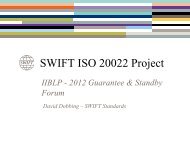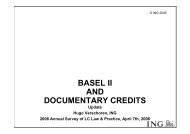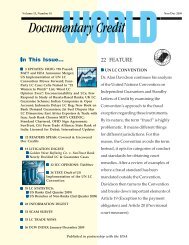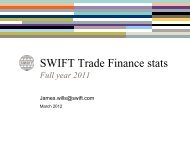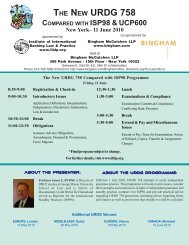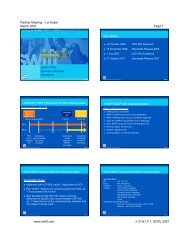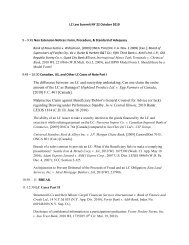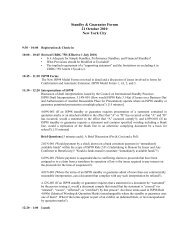FEATURE - The Institute of International Banking Law & Practice
FEATURE - The Institute of International Banking Law & Practice
FEATURE - The Institute of International Banking Law & Practice
Create successful ePaper yourself
Turn your PDF publications into a flip-book with our unique Google optimized e-Paper software.
<strong>FEATURE</strong><br />
<strong>The</strong> bill <strong>of</strong> lading showed the<br />
following information:<br />
Place <strong>of</strong> receipt:<br />
Umea, Sweden<br />
Ocean vessel:<br />
“vessel xx”<br />
Port <strong>of</strong> Loading:<br />
Hamburg<br />
Port <strong>of</strong> Discharge:<br />
Port Jebel Ali, Dubai<br />
by vessel<br />
<strong>The</strong> bill <strong>of</strong> lading stated that<br />
the goods were received for<br />
shipment and did not show<br />
any on board notation. <strong>The</strong><br />
issuing bank’s advice <strong>of</strong> refusal<br />
stated: “B/L doesn’t show<br />
port <strong>of</strong> loading as required<br />
under L/C field 44E.” <strong>The</strong><br />
presenting bank argued that<br />
because the credit allowed for<br />
presentation <strong>of</strong> a multimodal<br />
transport document, the bill <strong>of</strong><br />
lading should be examined in<br />
accordance with UCP600<br />
Article 19 (Transport<br />
Document Covering at Least<br />
Two Different Modes <strong>of</strong><br />
Transport). <strong>The</strong> presenting<br />
bank also stated that the letter<br />
<strong>of</strong> credit wording was<br />
ambiguous because it allowed<br />
for a document covering at<br />
least two different modes <strong>of</strong><br />
transport and required<br />
transportation between two<br />
(sea) ports. <strong>The</strong> issuing bank<br />
disagreed. In its analysis, the<br />
ICC agreed that the wording<br />
was ambiguous and further<br />
stated that this was a common<br />
way <strong>of</strong> structuring credits. <strong>The</strong><br />
ICC pointed out that the<br />
issuing bank bears the risk <strong>of</strong><br />
such ambiguity. <strong>The</strong> conclusion<br />
stated that the multimodal<br />
transport document complied<br />
as it showed transport<br />
between Umea and Jebel Ali.<br />
Panelist moderator<br />
MAULELLA stated that, based<br />
on this opinion, the advising<br />
bank should go back to the<br />
issuing bank to clarify<br />
requirements if such<br />
requirements are not clear.<br />
Other panelists added that the<br />
problem stems from the fact<br />
that issuers do not think about<br />
what they are going to receive.<br />
Due to volumes, many bank<br />
do not take the time to<br />
mitigate this type <strong>of</strong> risk.<br />
James WILLS (SWIFT)<br />
stated that the banking<br />
industry had been asking for<br />
these SWIFT Field changes for<br />
years but now that they are<br />
available, use <strong>of</strong> them has been<br />
“under-whelming”. Banks<br />
need to know how to use them<br />
and change their forms<br />
accordingly.<br />
ICC Opinion TA632rev<br />
relates to the situation <strong>of</strong> a<br />
100% transfer with no<br />
substitution. In addition to<br />
modifications that may be<br />
made per UCP600 Article<br />
38(g), can a transferring bank<br />
also modify Article 38(k) to<br />
allow presentation directly to<br />
the issuing bank instead <strong>of</strong> to<br />
the transferring bank If so,<br />
how should the transferring<br />
bank handle this and how<br />
does the issuing bank know<br />
this modification has been<br />
made <strong>The</strong> Opinion’s<br />
conclusion stated that a<br />
transferring bank can so<br />
modify sub-Article 38(k) and<br />
should inform the issuing bank<br />
who would otherwise have no<br />
way <strong>of</strong> knowing <strong>of</strong> the<br />
modification or even that a<br />
transfer has been effected.<br />
If the transferring bank<br />
does this without informing<br />
the issuing bank, one delegate<br />
mentioned that the<br />
transferring bank would be<br />
setting up the second<br />
beneficiary for a discrepancy<br />
because the issuing bank<br />
doesn’t know this has<br />
occurred.<br />
How does one reconcile this<br />
provision with UCP600 Article<br />
6(a) where the beneficiary can<br />
go directly to the issuing<br />
bank Some delegates believe<br />
there seems to be a conflict<br />
between UCP600 Articles 38(k)<br />
and 6(a), while others see no<br />
conflict.<br />
In the situation <strong>of</strong> this<br />
particular query when there is<br />
a 100% transfer with no<br />
substitution, the Opinion<br />
allows banks to modify<br />
UCP600 Articles 38(k).<br />
At least one panelist views<br />
this as a perfect example <strong>of</strong><br />
UCP 600 Article 38(k) not<br />
being enforceable in some<br />
situations and finds it shocking<br />
that the ICC would allow this<br />
sub-article to be unilaterally<br />
modified. If a transferring<br />
bank becomes insolvent or<br />
goes out <strong>of</strong> business, then the<br />
issuing bank should not be<br />
May 2008 Documentary Credit World 19




